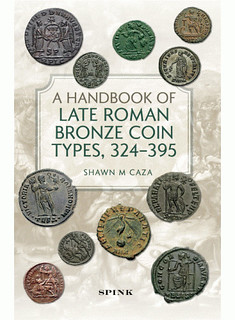
PREV ARTICLE
NEXT ARTICLE
FULL ISSUE
PREV FULL ISSUE
NEW BOOK: LATE ROMAN BRONZE COIN TYPESSPINK has published Shawn Caza's new book on late Roman coins. Here's the information from the SPINK website. -Editor
With more than 260 illustrations, and catalogue entries for each bronze reverse type struck from AD 324 to 395, this catalogue gives detailed information about the late Roman bronze coinage systems, with each entry including details on dates, mints, personalities, weight standard, important variations and the history and meaning of the legend and design. Extensive introductory notes in the first chapter discuss the life-cycle of late Roman bronze coins (manufacture, circulation, loss and the effects of burial) as well as their weight, fineness standards and contemporary value. The introductory sections of the subsequent chapters, each of which is dedicated to a short time period, cover the history of that period and the metrology (weight, size and metallic composition), overall pattern, and mint and field marks of the coinage of those years. It is the first detailed examination of the coinage of this period by reverse design, providing different insights from those gained through an examination of the coinage by Mint or by emperor, and incorporates the latest numismatic scholarship, plus extensive footnotes and bibliography. The indexed and cross-referenced catalogue entries will be of interest to collectors, cataloguers and researchers, with historical and metrological discussions appealing to scholars, numismatists and students alike, the focus on reverse types providing scholars working with hoards or site finds with much greater insight into dates and other aspects of the coinage than by simply identifying the emperor. Shawn kindly provided this additional text from the book's frontmatter. Thank you! -Editor About This Book The most common Roman coins - in archaeological excavations, metal detector finds, and on the commercial market - are late Roman bronze coins. These coins are also, ironically, the least studied Roman coins. Academic books, museum displays and auction catalogues tend to focus instead on the larger bronzes of the earlier Imperial Principate and on the more valuable silver and gold denominations. This book is meant in part to remedy that situation. The Romans began issuing coins in the third century BC and issued them in great numbers through the last 200 years of the Republic and the 500 years of the Empire. At its height, the Roman Empire likely had well over 60 million inhabitants living in a vast territory stretching from Scotland and Morocco, through to Iraq and Egypt. Roman merchants traveled much further to places such as Poland, southern Russia, India, Sri Lanka, Yemen and Ethiopia. Roman coins were used, and have been found, in all of these places. Huge numbers of Roman coins were struck and many still exist today. For example, in England alone, over 72,000 coins struck during the years 330 to 348 are officially documented from archaeological excavations, known hoards, and finds registered by metal detectorists through the PAS (Portable Antiquities Scheme). This averages to over 4,000 coins per year from that period, or approximately 11 coins per day. Of course these coins were neither struck nor lost in such an even manner, nor in fact were all coins struck during that period lost during those same years. Nevertheless, this provides an idea of the scale of Roman coinage. When we consider that these 72,000 coins represent only those found in England, only those officially registered, and only for an 18-year period in the mid-fourth century, then it is easy to understand the fact that there are many millions of Roman coins existing in collections today and that many billions of Roman coins were once struck. The bronze and copper coins from the last two centuries of the Roman Empire, struck during the period from 294 to 498, are usually referred to as late Roman bronze coins, or LRBCs. This book covers part of this coinage - the Roman bronze coinage struck from 324 to 395. Note on the Use of This Volume This book can be used in several different ways. 1) At its simplest, this book is a catalogue of late Roman bronze reverse types. Each chapter, after the first, examines the coinage of a period ranging from two to sixteen years in length. Together they cover the Roman bronze coinage of 324 to 395. Each of these chapters contains a catalogue of all the reverse types struck during that period. While rare types are covered, not every medallic issue is. Occasionally, several types are grouped together and follow a brief introduction which describes common features or notes. Readers looking up a specific reverse type should check the text above the entry to see if there is such an introduction as it will contain important notes about the coin type. Coin type entries can be found quickly by using the alphabetical Index of Reverse Legends, found at the back of this book. It is important to note that this book does not provide a full listing of every coin struck during this period - it does not list all coins by legend break, officina, mint and emperor. It examines the coinage in terms of reverse type. It is meant to complement works that provide a comprehensive listing by mint (The Roman Imperial Coinage (RIC), Late Roman Bronze Coinage (LRBC), Bastien, etc.), or by emperor (Sear), not to replace them. NOTE: SPINK is offering a 10% discount to E-Sylum readers. Should you have problems applying the discount through their website, contact books@spink.com . It is also available on Amazon and via numismatic literature dealer Charlie Davis at $75.00. -Editor
For more information, or to order, see:
Wayne Homren, Editor The Numismatic Bibliomania Society is a non-profit organization promoting numismatic literature. See our web site at coinbooks.org. To submit items for publication in The E-Sylum, write to the Editor at this address: whomren@gmail.com To subscribe go to: https://my.binhost.com/lists/listinfo/esylum All Rights Reserved. NBS Home Page Contact the NBS webmaster 
|

